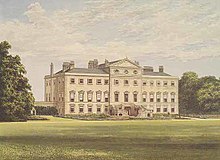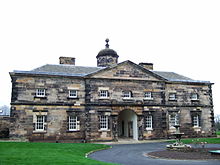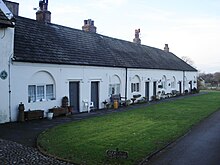Lathom House
Lathom House was a large country house in the village of Lathom in the English county of Lancashire . The main building was demolished in 1925.
Early history

A wooden castle is said to have stood here in the Middle Ages.
The stone building, which was called "Lathom House" and was built in 1496 for the Stanley family , had 18 towers and was surrounded by a 1.8 meter thick wall and an eight meter moat , the drawbridge of which could be defended by a gate tower . In the middle of the complex was a tall tower called the Eagle Tower .
In 1594, the Protestant martyr George Marsh was interviewed at Lathom House by Edward Stanley before he was sent to Lancaster Castle .
Lathom House was the last royalist retreat in Lancashire during the English Civil War and was besieged twice by parliamentary troops. During the first siege by Sir Thomas Fairfax in 1644 , Charlotte Stanley, Countess of Derby , and 300 men defended the house until the royalist troops under Ruprecht of the Palatinate, Duke of Cumberland , arrived in the area on their way to Bolton . After the siege, the Countess and her entourage fled to the Isle of Man .
In 1645 the house was besieged again, this time by General Egerton and 4,000 parliamentary soldiers. After a continued siege, in which the fortifications were destroyed by the parliamentarians, the defenders had to hand over the house to them. James Stanley , Charlotte's husband, was beheaded by the parliamentarians in Bolton in 1651 for high treason. The Stanley's property was confiscated by Parliament.
After the Stuart restoration
After the Stuart Restoration in 1660, Lathom House was returned to the Stanley family and remained in the family until 1714 when it fell to John Ashburnham, 3rd Baron Ashburnham , through Henrietta Stanley's marriage to John Ashburnham, 3rd Baron Ashburnham , and he sold it.
It was later bought by Sir Thomas Bootle , MP for Liverpool , who commissioned Giacomo Leoni to convert it into the most beautiful Palladian house in the country. His deer park, which was created 1725-1740, was designed by the well-known landscape architect Humphry Repton and contained The Lines , with a length of 4 km, the grandest avenue in England in the 17th century. There was also a temple, a hunting lodge, and a Gothic dairy. The north facade of the country house was 47 meters long and the surrounding parkland was 5–6 km in circumference.
Through Thomas Bootle's niece, the property fell to Richard Wilbraham-Bootle and their son, Edward Bootle-Wilbraham, 1st Baron Skelmersdale . The latter's grandson, Edward , inherited the property and was named Earl of Lathom . During the First World War , the country house was used for military purposes, mainly the training of horses. After the war, the 3rd Earl decided against renovating it and using it again as a family residence. Instead, he lived in nearby Blythe Hall .
The property was sold to a London consortium in 1920. After a short period as a boys' school, the main block was demolished in 1925. The 1000 hectare property of the country house was sold piece by piece, mainly to tenants. The remaining west wing of the house was converted into apartments.
Excavations
The ruins of Lathom House were excavated by the Historical Council of Northern Lancashire to recreate the 18th century buildings. The team found medieval foundations and tried to save them. While the main buildings became uninhabitable a few decades ago, there are still small houses near the chapel of Lathom Park.
Individual evidence
- ^ John Foxe: Foxe's Book of Martyr .
- ^ Samuel Lewis: Lathom . In: A Topographical Dictionary of England . British History Online. Pp. 30-33. 1848. Retrieved April 12, 2018.
- ^ William Farrer, J. Brownbill (editor): Lathom . In: A History of the County of Lancaster: Volume 3 . British History Online. Pp. 25-34. 1907. Retrieved April 12, 2018.
- ↑ England's lost Downtons . In: Daily Mail . February 16, 2012. Retrieved April 12, 2018.
- ^ John Robinson: Felling the Ancient Oaks . Aurum Press, 2011. ISBN 978-1-845136-70-3 . P. 136.
Web links
Coordinates: 53 ° 34 ′ 32.9 " N , 2 ° 49 ′ 1.2" W.


